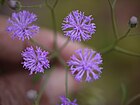Note: This is a project under development. The articles on this wiki are just being initiated and broadly incomplete. You can Help creating new pages.
Cyanthillium cinereum - Sahadevi
Sahadevi is an erect, branching, annual plant. It grows upto 15 - 80cm tall. The plant is harvested from the wild for local use as a food and medicine.
Contents
- 1 Uses
- 2 Parts Used
- 3 Chemical Composition
- 4 Common names
- 5 Properties
- 6 Habit
- 7 Identification
- 8 List of Ayurvedic medicine in which the herb is used
- 9 Where to get the saplings
- 10 Mode of Propagation
- 11 How to plant/cultivate
- 12 Commonly seen growing in areas
- 13 Photo Gallery
- 14 References
- 15 External Links
Uses
Wound healing, Renal calculi, Burning micturition, Insomnia, Skin diseases, Intestinal worms.[1]
Food
Cyanthillium cinereum can be used in Food. Tender leaves are cooked as vegetable.[2]
Parts Used
Chemical Composition
It contains Caryophyllene oxide (16.7 %) was the major compound followed by n-hexadecanoic acid (8.9 %) and phytol etc.[3]
Common names
| Language | Common name |
|---|---|
| Kannada | Dandothpala, Gaaya doppalu, Gaayathoppalu, Kaadu hoge soppu, Sahadevi |
| Hindi | Daudotpala, Kalgira, Kaljiri, Sadodi, Sadori, Sahadevi |
| Malayalam | Puvamkuruntal |
| Tamil | Cakatevi, Cirilai, Citevi, Cenkalunir, Puvamkuruntal |
| Telugu | Garita kammi, Garitikamma, Gharitikamini |
| Marathi | NA |
| Gujarathi | NA |
| Punjabi | NA |
| Kashmiri | NA |
| Sanskrit | Sahadevi, Ardhaprasadana, Dandotpala, Vishvadeva |
| English | Ash-colour fleabane, Purple fleabane |
.[4]
Properties
Reference: Dravya - Substance, Rasa - Taste, Guna - Qualities, Veerya - Potency, Vipaka - Post-digesion effect, Karma - Pharmacological activity, Prabhava - Therepeutics.
Dravya
Rasa
Tikta (Bitter)
Guna
Laghu (Light), Rooksha (Dry)
Veerya
Ushna (Hot)
Vipaka
Katu (Pungent)
Karma
Kapha, Vata
Prabhava
Nutritional components
Cyanthillium cinereum Contains the Following nutritional components like - Vitamin-A, B and C; Tannins; Flavonoides; Saponins; Glycosides; Calcium, Copper, Iron, Magnesium, Manganese, Potassium, Phosphorus, Sodium, Sulphur Zinc[2]
Habit
Identification
Leaf
| Kind | Shape | Feature |
|---|---|---|
| Simple | Alternate | Leaves variable, 2-8 x 1-3 cm, ovate, acute at both ends, thinly hairy below. |
Flower
| Type | Size | Color and composition | Stamen | More information |
|---|---|---|---|---|
| Bisexual | Terminal corymbose heads | Pink | Peduncled; outer bracts minute, inner oblong, acute, cuspidate, hairy. Flowers 5-10, similar; corolla 3 mm long, glabrous, bluish-purple. |
Fruit
| Type | Size | Mass | Appearance | Seeds | More information |
|---|---|---|---|---|---|
| Achene | 1.5 mm long | Hairy, outer pappus 1 mm long, setaceous, inner 3 mm long. | {{{6}}} |
Other features
List of Ayurvedic medicine in which the herb is used
Where to get the saplings
Mode of Propagation
How to plant/cultivate
Cyanthillium cinereum is available through July to February[2].
Season to grow
Soil type
Propagation
Commonly seen growing in areas
Tropical areaSub tropical area
Photo Gallery
References
- ↑ Uses
- ↑ 2.0 2.1 2.2 "Forest food for Northern region of Western Ghats" by Dr. Mandar N. Datar and Dr. Anuradha S. Upadhye, Page No.149, Published by Maharashtra Association for the Cultivation of Science (MACS) Agharkar Research Institute, Gopal Ganesh Agarkar Road, Pune
- ↑ Chemical constituents
- ↑ Vernacular names
- ↑ FLOWERING PLANTS OF KERALA VER.2 by N. Sasidharan
External Links
- Ayurvedic Herbs known to be helpful to treat Wound healing
- Ayurvedic Herbs known to be helpful to treat Renal calculi
- Ayurvedic Herbs known to be helpful to treat Burning micturition
- Ayurvedic Herbs known to be helpful to treat Insomnia
- Ayurvedic Herbs known to be helpful to treat Skin diseases
- Ayurvedic Herbs known to be helpful to treat Intestinal worms
- Herbs with Root used in medicine
- Herbs with common name in Kannada
- Herbs with common name in Hindi
- Herbs with common name in Malayalam
- Herbs with common name in Tamil
- Herbs with common name in Telugu
- Herbs with common name in Sanskrit
- Herbs with common name in English
- Habit - Herb
- Index of Plants which can be propagated by Seeds
- Herbs that are commonly seen in the region of Tropical area
- Herbs that are commonly seen in the region of Sub tropical area
- Herbs
- Asteraceae




